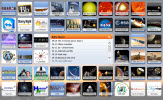November 2018
This month
Click here for the month at a glance calendar.
 17 November 5:30 pm CST
17 November 5:30 pm CST
Mercury moves into the evening skies but it stays too low over the western horizon to be seen from the Northern Hemisphere.
Venus reappears as a morning planet during the last two weeks of the month.
Mars is visible over the southern horizon at sunset setting around midnight local time. As the distance between Earth and Mars continues to increase Mars will noticeably dim in apparent magnitude.
Dwarf Planet Ceres is too close to the Sun and moves into solar conjunction on the 7th.
Jupiter is very low over the western horizon at sunset local time and is increasingly difficult to observe. Jupiter moves into solar conjunction on the 26th.
Saturn is visible but low over the southwestern horizon at sunset local time and sets about 2 hours after the Sun.















 Above the Solar System at 10 day Intervals
Above the Solar System at 10 day Intervals

 Lee's Summit, MO
Lee's Summit, MO 